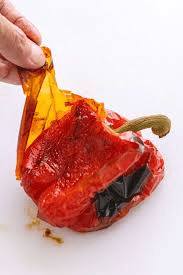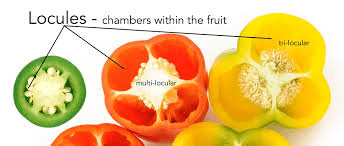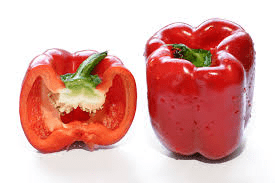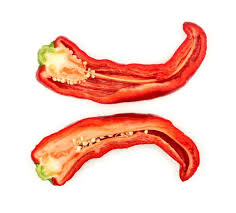Pepper pulp refers to the soft, fleshy part of the pepper fruit that surrounds the seeds and placenta. It is the edible portion of the pepper that varies in texture and flavor depending on the type of pepper and its ripeness.
In culinary use, pepper pulp is prized for its sweet, tangy, or spicy flavor profiles, which can range from mild in bell peppers to intensely hot in chili peppers. The pulp is often diced, sliced, or pureed and used in various dishes to add flavor, texture, and color. It serves as a key ingredient in salads, salsas, sauces, stir-fries, and soups, contributing both taste and nutritional value.
Nutritionally, pepper pulp is rich in vitamins, especially vitamin C, which provides antioxidant benefits. It also contains dietary fiber and other essential nutrients, making it a healthy addition to meals. Depending on the variety and ripeness of the pepper, the pulp may vary in color from green and yellow to red, orange, or even purple.
In food processing, pepper pulp can be extracted and processed further into products like pepper puree, paste, or sauces, which are convenient for culinary use and preservation. These processed forms are often used in commercial food production to flavor dishes consistently and efficiently.
Beyond culinary applications, pepper pulp has potential uses in biotechnology and pharmaceuticals. Extracts from pepper pulp may contain bioactive compounds such as antioxidants and anti-inflammatory agents, which have implications for health and wellness products.
From a waste management perspective, pepper pulp and other by-products from processing can be recycled or repurposed. For instance, they can be composted to enrich soil fertility or used as animal feed, reducing waste and maximizing resource efficiency in agricultural settings.
Pepper pulp plays a versatile role in culinary arts, nutrition, and potentially in other industries. Its distinct flavors, nutritional benefits, and adaptability make it a valuable ingredient that enhances both the taste and nutritional value of dishes around the world.
The Economic Importance and Uses of Pepper Pulp

1. Food Processing: Pepper pulp is used in making sauces, soups, and purees, providing a rich base for various culinary products.
2. Nutritional Value: Rich in vitamins A, C, and antioxidants, pepper pulp is included in health drinks and nutritional supplements.
3. Flavoring Agents: Pepper pulp enhances the flavor in processed foods like sauces, dips, and marinades.
4. Preservatives: The natural antimicrobial properties of pepper pulp help in preserving foods, extending their shelf life.
5. Food Coloring: Natural pigments in pepper pulp are used as colorants in food products.
6. Beverage Industry: Pepper pulp is used in spicy beverages and cocktail mixers, adding unique flavors and nutritional benefits.
7. Health Foods: Included in health bars, snacks, and diet foods for added flavor and nutrients.
8. Animal Feed: Residual pulp from processing can be used as a nutrient-rich addition to animal feed.
9. Organic Fertilizer: Leftover pulp is composted to create organic fertilizers for agriculture.
10. Traditional Medicine: In some cultures, pepper pulp is used in traditional remedies for its purported health benefits.
11. Export Revenue: Processed pepper pulp products are exported, contributing to the economy of producing countries.
12. Culinary Tourism: Regions known for pepper production use pulp in local dishes, attracting food enthusiasts and boosting tourism.
13. Canning Industry: Pepper pulp is used in canned products, providing a flavorful ingredient that preserves well.
14. Food Innovation: Pepper pulp is utilized in developing new food products and culinary innovations.
15. Waste Reduction: Using pepper pulp in various industries helps in reducing food waste.
16. Cosmetic Industry: Extracts from pepper pulp are used in skincare products for their beneficial properties.
17. Nutraceuticals: The health benefits of pepper pulp make it a valuable ingredient in functional foods and nutraceuticals.
18. Biofuel Research: Research is ongoing into the potential of using pepper pulp biomass for biofuel production.
Read Also: How to Control Cannibalism among Fishes
The Products and By-products That Can Be Derived From Pepper Pulp

1. Hot Sauce: Made by blending pepper pulp with vinegar, spices, and other ingredients.
2. Pepper Puree: Used as a base for soups, sauces, and culinary preparations.
3. Pepper Jelly: A sweet and spicy jelly made from pepper pulp, used as a spread or condiment.
4. Salsa: A mixture of chopped pepper pulp, tomatoes, onions, and other ingredients.
5. Pepper Paste: Concentrated pulp used in cooking, especially in Asian and Middle Eastern cuisines.
6. Spicy Beverages: Pepper pulp is used in making spicy drinks and cocktail mixers.
7. Canned Peppers: Pulp is used in canning, preserving the flavor and nutritional value.
8. Pickled Peppers: Pulp is included in pickled products, enhancing their flavor and texture.
9. Pepper Sauce: Various sauces are made using pepper pulp as the primary ingredient.
10. Flavor Extracts: Extracts from pepper pulp are used to flavor snacks, soups, and prepared meals.
11. Natural Colorants: Pigments in the pulp are used as natural food colorings.
12. Health Supplements: Pulp is processed into supplements for its nutritional benefits.
13. Nutritional Drinks: Added to health drinks and smoothies for flavor and nutrients.
14. Animal Feed: Residual pulp is used as a nutritious component in livestock feed.
15. Organic Compost: Pepper pulp is composted to create rich organic fertilizer.
16. Cosmetic Ingredients: Extracts from pulp are used in skincare and beauty products.
17. Biofuel: Research is exploring the use of pepper pulp biomass for renewable energy.
Read Also: Factors to Consider when Selecting your Fish Farming Site
Frequently Asked Questions (FAQ’s) About Pepper Pulp

1. What is pepper pulp?
Pepper pulp is the fleshy part of the pepper fruit, processed and used in various culinary and industrial applications.
2. What are the health benefits of pepper pulp?
Rich in vitamins A, C, antioxidants, and fiber, pepper pulp supports overall health and wellness.
3. How can I use pepper pulp in cooking?
Pepper pulp can be used in making sauces, soups, purees, jellies, and salsas, adding rich flavor and nutrients.
4. How should I store pepper pulp?
Pepper pulp can be stored in the refrigerator for a few days or frozen for longer shelf life.
5. Can I eat pepper pulp raw?
Yes, pepper pulp can be eaten raw and is often used in fresh salsas and salads.
6. Are there any side effects of consuming pepper pulp?
Pepper pulp is generally safe, but excessive consumption of spicy varieties may cause digestive discomfort for some individuals.
7. How is pepper pulp processed?
Pepper pulp is obtained by blending or crushing the pepper fruit and can be further processed into various products.
8. Can pepper pulp be frozen?
Yes, pepper pulp can be frozen to extend its shelf life and maintain its quality.
9. What are some common varieties of pepper pulp?
Common varieties include bell pepper, jalapeño, habanero, cayenne, and poblano pulp, each with unique flavors and heat levels.
10. How is pepper pulp used in traditional medicine?
Pepper pulp is used in some traditional remedies for its purported benefits in treating colds, digestive issues, and inflammation.






